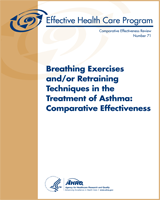NCBI Bookshelf. A service of the National Library of Medicine, National Institutes of Health.
O’Connor E, Patnode CD, Burda BU, et al. Breathing Exercises and/or Retraining Techniques in the Treatment of Asthma: Comparative Effectiveness [Internet]. Rockville (MD): Agency for Healthcare Research and Quality (US); 2012 Sep. (Comparative Effectiveness Reviews, No. 71.)
This publication is provided for historical reference only and the information may be out of date.

Breathing Exercises and/or Retraining Techniques in the Treatment of Asthma: Comparative Effectiveness [Internet].
Show details| Medication | Drug class | Product(s) | Indications | Mechanism | Potential adverse effects |
|---|---|---|---|---|---|
| Long-term control medications | Inhaled corticosteroids | Beclomethasone dipropionate, budesonide, flunisolide, fluticasone propionate, mometasone furoate, triamcinolone acetonide | Long-term prevention of symptoms; suppression, control and reversal of inflammation. Reduce need for oral corticosteroids. | Anti-inflammatory, blocks late reaction to allergen and reduces airway hyper-responsiveness and inhibits cytokine production, adhesion protein activation and inflammatory cell migration and activation... Reverse beta2-receptor downregulation. Inhibit microvascular leakage. | Cough, dysphonia, oral thrush (candidiasis). Systemic effects may occur with high doses (e.g., adrenal suppression, osteoporosis, skin thinning, and easy bruising). Suppression of growth velocity seen in children taking low to medium doses (transient effect). |
| Systemic corticosteroids | Methyl-prednisolone, prednisolone, prednisone | For short-term “burst” control and for long-term prevention of symptoms in severe persistent asthma (suppression, control, and reversal of inflammation). | Same as ICS. | Short term use: reversible abnormalities in glucose metabolism, increased appetite, fluid retention, weight gain, hypertension, mood alteration, peptic ulcer, rarely aseptic necrosis. Long-term use: adrenal axis suppression, dermal thinning, growth suppression, hypertension, diabetes, Cushing’s syndrome, muscle weakness, cataracts, impaired immune function (rare). | |
| Cromolyn sodium and nedocromil | NA | Long-term prevention of symptoms of mild persistent asthma. Preventive treatment prior to exercise or allergen exposure. | Anti-inflammatory, blocks early and late reaction to allergen, interferes with chloride channel function, and stabilizes mast cell membranes and inhibits activation and release of mediators from eosinophils and epithelial cells. Inhibits acute response to exercise, cold dry air and sulfuric dioxide. | Cough and irritation, unpleasant taste for nedocromil. | |
| Immunomodulators | Omalizumab | Long-term control and prevention of symptoms in moderate to severe persistent allergic asthmatics inadequately controlled by ICS. | Prevention of IgE binding to high-affinity receptors on basophils and mast cells. Decrease mast cell mediator from allergen exposure. Decrease number of high-affinity receptors in basophils and submucosal cells. | Pain and bruising at injection site, anaphylaxis, and malignant neoplasms (unclear relationship). | |
| Leukotriene receptor antagonists | Montelukast tablets and granules, zafirlukast tablets | Long-term control and prevention of symptoms in mild persistent asthma patients | Leukotriene receptor antagonists, selective competitive inhibition of CysLT1 receptor. | No specific AEs reported for montelukast except Churg-Strauss (rare). Reversible hepatitis and rare irreversible hepatic failure (liver transplant and death) for zafirlukast. | |
| 5-Lipo-oxygenase inhibitor | Zileuton tables | Long-term control and prevention of symptoms in mild persistent asthma patients aged ≥ 12 years | Inhibits production of leukotrienes from arachidonic acid | Elevation of liver enzymes and limited case reports of reversible hepatitis and hyperbilirubinemia. | |
| Long-acting beta2-agonists | Inhaled formoterol and salmeterol; albuterol sustained-release tablets | Long-term prevention of symptoms in addition to ICS. Prevention of exercise-induced bronchospasm. | Bronchodilation, smooth muscle relaxation following adenylate cyclase activation and increase in cyclic AMP producing functional antagonism of bronchoconstriction. | Tachycardia, skeletal muscle tremor, hypokalemia, prolongation of QTc interval in overdose. Diminished bronchoprotective effects. Potential risk of uncommon, severe, life-threatening or fatal exacerbation. | |
| Methyl-xanthines | Theophylline sustained-release tablets and capsules | Long-term control and prevention of symptoms in mild persistent asthma or as adjunctive with ICS in moderate or persistent asthma. | Bronchodilation, smooth muscle relaxation from phosphodiesterase inhabitation and possible adenosine antagonism. May affect eosinophilic infiltration to bronchial mucosa as well as decrease in epithelial T-lymphocyte. Increases diaphragm contractility and mucociliary clearance. | Insomnia, gastric upset, ulcer aggravation or reflux, hyperactivity (children), urination difficulties (elderly men with prostatism). Dose-related acute toxicities (e.g., tachycardia, nausea, CNS stimulation, hyperkalemia SVT, seizures, vomiting, headache, hematemesis, and hyperglycemia). | |
| Quick-relief medications | Short-acting beta2-agonists | Inhaled albuterol, levalbuterol and pirbuterol | Relief of acute symptoms and preventive treatment for exercise-induced bronchospasm prior to exercise. | Bronchodilation, binds to the beta2-adrenergic receptor producing smooth muscle relaxation following adenylate cyclase activation and increase in cyclic AMP producing functional antagonism of bronchoconstriction. | Tachycardia, skeletal muscle tremor, lactic acid increase, headache, hyperglycemia. Patients with cardiovascular conditions may have adverse cardiovascular reactions. |
| Anticholinergics | Ipratropium bromide | Relief of acute bronchospasm. | Bronchodilation, competitive inhibition of muscarinic cholinergic receptors. Reduced intrinsic vagal tone of airways may block reflex bronchoconstriction secondary to irritants or to reflux eosinophils. May decrease mucous gland secretion. | Dry mouth, wheezing, and blurred vision if sprayed in eyes. | |
| Corticosteroids | Methylprednisolone, prednisolone, prednisone | Prevent progression, reverse inflammation, speed recovery, and reduce relapse rate in exacerbations. | Same as ICS. | Reversible abnormalities in glucose metabolism, increased appetite, fluid retention, facial flushing, weight gain, hypertension, mood alteration, peptic ulcer, aseptic necrosis (rare). |
Adapted from the National Asthma Education and Prevention Program’s Prevention Guidelines for the Diagnosis and Management of Asthma (Figures 3-22 and 3-23)1
Abbreviations: AE: adverse effect; AMP: adeno monophosphate; CNS: central nervous system; ICS: inhaled corticosteroids; SVT: supraventricular tachycardia
- Medications Recommended for Use in Treating Asthma - Breathing Exercises and/or ...Medications Recommended for Use in Treating Asthma - Breathing Exercises and/or Retraining Techniques in the Treatment of Asthma: Comparative Effectiveness
Your browsing activity is empty.
Activity recording is turned off.
See more...